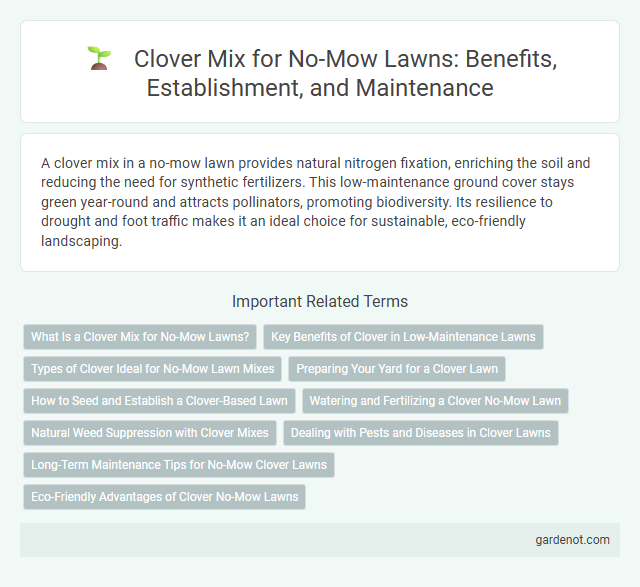A clover mix in a no-mow lawn provides natural nitrogen fixation, enriching the soil and reducing the need for synthetic fertilizers. This low-maintenance ground cover stays green year-round and attracts pollinators, promoting biodiversity. Its resilience to drought and foot traffic makes it an ideal choice for sustainable, eco-friendly landscaping.
What Is a Clover Mix for No-Mow Lawns?
A clover mix for no-mow lawns consists primarily of low-growing white clover varieties combined with other drought-tolerant, low-maintenance ground covers. This blend promotes soil nitrogen fixation, reducing the need for fertilizers while maintaining a lush, green appearance without regular mowing. Clover mixes improve lawn durability, support pollinators, and require less water compared to traditional grass lawns.
Key Benefits of Clover in Low-Maintenance Lawns
Clover mix enhances low-maintenance lawns by naturally fixing nitrogen, reducing the need for synthetic fertilizers and promoting healthier grass growth. Its deep root system improves soil structure and retains moisture, leading to drought-resistant lawns that require less watering. Clover also suppresses weeds and attracts pollinators, supporting biodiversity while minimizing maintenance efforts.
Types of Clover Ideal for No-Mow Lawn Mixes
Microclover and Dutch white clover are the most popular types ideal for no-mow lawn mixes due to their low growth habits and nitrogen-fixing abilities, which naturally enrich soil and reduce the need for fertilizers. Microclover stays compact and blends well with grass, maintaining a uniform look without frequent mowing. Dutch white clover thrives in diverse soil conditions and provides durability and resilience, making it a perfect choice for establishing a sustainable no-mow lawn.
Preparing Your Yard for a Clover Lawn
Preparing your yard for a clover lawn requires thorough soil testing to ensure optimal pH levels between 6.0 and 7.0, promoting healthy clover growth. Remove existing grass and weeds by mowing low or using a non-selective herbicide, then rake the soil to create a smooth, well-drained seedbed for the clover mix. Regularly water the area after planting to maintain consistent moisture, which encourages strong root establishment and a lush, no-mow clover lawn.
How to Seed and Establish a Clover-Based Lawn
To seed and establish a clover-based no-mow lawn, prepare the soil by removing existing grass and loosening the top 2 inches with a rake to improve seed-to-soil contact. Spread a high-quality white clover seed mix evenly at a rate of about 2 to 3 pounds per 1,000 square feet, then lightly rake the soil to cover the seeds and water consistently to keep the soil moist during the germination period of 7 to 14 days. Fertilize with a low-nitrogen fertilizer to promote clover growth, avoiding high nitrogen levels that encourage weed growth and mowing only when necessary to maintain clover health and lawn aesthetics.
Watering and Fertilizing a Clover No-Mow Lawn
A Clover No-Mow Lawn requires minimal watering, thriving well with natural rainfall and only supplemental watering during prolonged dry spells to maintain deep root growth. Fertilizing is generally unnecessary, as clover naturally fixes nitrogen, enriching the soil and promoting healthy, green foliage without the need for synthetic fertilizers. Maintaining proper soil pH around 6.0 to 7.0 further supports nutrient uptake and maximizes the benefits of clover's natural resilience.
Natural Weed Suppression with Clover Mixes
Clover mixes provide effective natural weed suppression by outcompeting weeds for nutrients, sunlight, and water, reducing the need for chemical herbicides. Their dense ground cover and nitrogen-fixing properties enhance soil health while inhibiting weed seed germination. Integrating clover into no-mow lawns promotes a sustainable, low-maintenance landscape with improved biodiversity and weed control.
Dealing with Pests and Diseases in Clover Lawns
Clover mix lawns naturally repel many common pests such as aphids and whiteflies due to their dense foliage and nitrogen-fixing properties. Incorporating beneficial insects like ladybugs enhances pest control without harmful chemicals, promoting a balanced ecosystem. Regular monitoring and maintaining proper moisture levels reduce disease risks such as powdery mildew, ensuring a healthy, resilient no-mow clover lawn.
Long-Term Maintenance Tips for No-Mow Clover Lawns
No-mow clover lawns require minimal watering but benefit from occasional deep watering during prolonged droughts to encourage deep root growth. Mowing is rarely needed; if necessary, set the mower blade high to avoid damaging clover leaves and promoting dense growth. Regular soil testing every 2-3 years helps maintain optimal pH and nutrient levels, supporting clover's nitrogen-fixing abilities for sustainable, low-maintenance turf.
Eco-Friendly Advantages of Clover No-Mow Lawns
Clover mix lawns provide significant eco-friendly advantages by improving soil health through natural nitrogen fixation, reducing the need for chemical fertilizers and lowering environmental pollution. Their dense growth minimizes weed proliferation and supports pollinators like bees, promoting biodiversity and ecosystem balance. Clover no-mow lawns also require less water than traditional grass, conserving vital water resources in residential and commercial landscapes.
Clover mix Infographic

 gardenot.com
gardenot.com